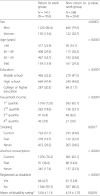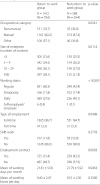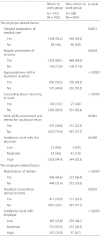1. Lee HK, Suh KH. A qualitative study on the psychological problems of injured workers. Korean J Health Psychol. 2014; 19:431–442. DOI:
10.17315/kjhp.2014.19.1.024.
2. Park SK. Factors associated with depression among injured workers with disabilities returning to work in South Korea: comparison of return to pre-injury job with work at a new firm. Korean J Soc Welfare Res. 2013; 37:149–185.
3. Lee J-e. A study on factors affecting learned helplessness of disabled workers due to industrial injury in Korea. In Department of Social Welfare. Library of Yonsei University: The Graduate School of Yonsei University; 2000.
4. Kim JW. An analysis of the effect of rehabilitation policy for the industrial accident disabled on employment performance. Korean J Public Admin. 2013; 51:247–276.
5. Lee S-W, Kim S-K. A thoughts on introducing a mandatory return-to-work provision for industrially injured workers in Korea. Korean J Phys Mult Health. 2014; 57:71–92.
6. Zhu Y, Chen PY, Zhao W. Injured workers in China: injustice, conflict and social unrest. Int Labour Rev. 2014; 153:635–647. DOI:
10.1111/j.1564-913X.2014.00015.x.
7. Takala J, Hämäläinen P, Saarela KL, Yun LY, Manickam K, Jin TW, et al. Global estimates of the burden of injury and illness at work in 2012. J Occup Environ Hyg. 2014; 11:326–337. DOI:
10.1080/15459624.2013.863131. PMID:
24219404.
8. Lee S-W, Shin T-S. The Business Owner's affecting factors to return to work after industrial accident. Korean Soc Secur P. 2013; 1:209–239.
9. MacEachen E, Clarke J, Franche R-L, Irvin E. Systematic review of the qualitative literature on return to work after injury. Scand J Work Environ Health. 2006; 32(4):257–269. DOI:
10.5271/sjweh.1009. PMID:
16932823.
10. Kim I, Rhie J, Yoon J-D, Kim J, Won J. Current situation and issue of Industrial Accident Compensation insurance. J Korean Med Sci. 2012; 27:S47–S54. DOI:
10.3346/jkms.2012.27.S.S47. PMID:
22661871.
11. Nordgren L, Söderlund A. Associations between socio-demographic factors, encounters with healthcare professionals and perceived ability to return to work in people sick-listed due to heart failure in Sweden: a cross-sectional study. Disabil Rehabil. 2015; 16:1–6.
12. Kivistö S, Verbeek JH, Hirvonen M, Varonen H. Return-to-work policies in Finnish occupational health services. Occup Med. 2008; 58:88–93. DOI:
10.1093/occmed/kqm138.
13. Edlund C, Dahlgren L. The physician's role in the vocational rehabilitation process. Disabil Rehabil. 2002; 24:727–733. DOI:
10.1080/09638280210124310. PMID:
12396658.
14. Nieuwenhuijsen K, Verbeek J, De Boer A, Blonk R, Van Dijk F. Supervisory behaviour as a predictor of return to work in employees absent from work due to mental health problems. Occup Environ Med. 2004; 61:817–823. DOI:
10.1136/oem.2003.009688. PMID:
15377767.
15. Muijzer A, Groothoff J, Geertzen J, Brouwer S. Influence of efforts of employer and employee on return-to-work process and outcomes. J Occup Rehabil. 2011; 21:513–519. DOI:
10.1007/s10926-011-9293-5. PMID:
21328060.
16. Lee S-J. The return-to-work system of the industrially injured workers in Korea. J Vocat Rehabil. 2011; 20:1–33.
17. Kang HT, Im HJ, Kim YK, Ju YS, Lee HP, Kim JM, et al. Predictors of return to work and job retention after work-related injury or illness. Korean J Occup Environ Med. 2006; 18:221–231.
18. Jeong WM, Park CY, Koo JW. Predictors of return to work in occupational injured workers. Korean J Occup Environ Med. 2003; 15:119–131.
19. Kant I, Jansen NW, Van Amelsvoort LG, Van Leusden R, Berkouwer A. Structured early consultation with the occupational physician reduces sickness absence among office workers at high risk for long-term sickness absence: a randomized controlled trial. J Occup Rehabil. 2008; 18:79–86. DOI:
10.1007/s10926-007-9114-z. PMID:
18196446.
20. Delbanco TL. Enriching the doctor-patient relationship by inviting the patient's perspective. Ann Intern Med. 1992; 116:414–418. DOI:
10.7326/0003-4819-116-5-414. PMID:
1736775.
21. Shevde K, Panagopoulos G. A survey of 800 patients' knowledge, attitudes, and concerns regarding anesthesia. Anesth Analg. 1991; 73:190–198. DOI:
10.1213/00000539-199108000-00013. PMID:
1854034.
23. Choi YY. A study on the rehabilitation service and policy for injured workers. J Vocat Rehabil. 2009; 19:121–142.
24. Blackwell TL, Leierer SJ, Haupt S, Kampitsis A. Predictors of vocational Rehabilitation return-to-work outcomes in workers' compensation. Rehabil Couns Bull. 2003; 46:108–114. DOI:
10.1177/00343552030460020501.
25. Jeong J-H, Park Y-D, Oh J-Y. A study on the employer's perception and corresponding types of the industrial accident compensation insurance. J Korea Saf Manag Sci. 2013; 15:87–100. DOI:
10.12812/ksms.2013.15.1.87.
26. Rusch MD, Dzwierzynski WW, Sanger JR, Pruit NT, Siewert AD. Return to work outcomes after work-related hand trauma: the role of causal attributions. J Hand Surg. 2003; 28:673–677. DOI:
10.1016/S0363-5023(03)00178-3.
27. Choi M, Kim H-R, Lee J, Lee H-E, Byun J, Won JU. Workers' experiences with compensated sick leave due to musculoskeletal disorder: a qualitative study. Ann Occup Environ Med. 2014; 26:33. DOI:
10.1186/s40557-014-0033-0. PMID:
25852943.
28. Franche R-L, Cullen K, Clarke J, Irvin E, Sinclair S, Frank J, et al. Workplace-based return-to-work interventions: a systematic review of the quantitative literature. J Occup Rehabil. 2005; 15:607–631. DOI:
10.1007/s10926-005-8038-8. PMID:
16254759.









 PDF
PDF Citation
Citation Print
Print


 XML Download
XML Download